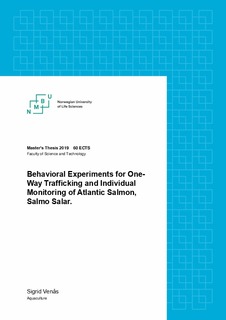| dc.description.abstract | The following experiments were set up to imitate the behavior of entering a feeding station, enabling individual monitoring of feed intake in Atlantic salmon, Salmon salar. This will not only increase the feed efficiency directly, but also be of great interest regarding breeding, enabling more accurate research of the heritability of feed efficiency traits in Atlantis salmon. In the first experiment hatches for one-way trafficking of fish were tested, by dividing a tank into two sides by a plexiglass wall attaching one-way hatches to two holes in the wall in different directions, having the fish swim through a hatch to access feed in one direction only. Inspired by traditional fish traps and fishing gear the hatches were cone-formed with the exit pointing out from the wall, limiting the fish’s ability to detect the exit opening, and cross through in the wrong direction. Further, the direction of the current through the hatches and the hatch size were tested to see how it would affect the cross behavior. The fish was monitored by a web-camera installed over the tank, programmed to take pictures every second during meals and record when movement through the hatches were detected. This led to thousands of pictures and hours of videos used to observe the cross behavior. Close to 100% of all crosses through the hatches were in the right direction and the fish preferred to cross against the current. The shape of the hatch was of greater importance than the direction of the current through the hatches. Further, three experiments were done to investigate the possibilities of getting one fish to enter a feeding area through one hatch, and back into a holding area through another hatch, and whether this behavior could be affected by increased flow and different feeding-regimens. Plexiglass were used to install a restricted feeding area in the tank, with the hatches used in the first experiment attached to each side to secure crossing in one direction only. The ability to utilize the feeding area increased over time and with higher flow through the hatches. These experiments demonstrate the possibilities of Atlantic salmon to enter a restricted area to feed, and the behavior observed can be used to further develop feeding stations for individual monitoring in aquaculture. | nb_NO |

